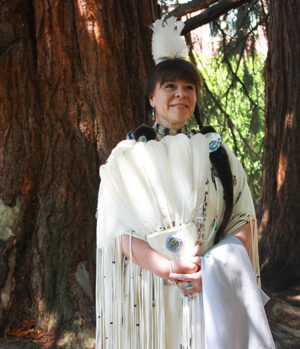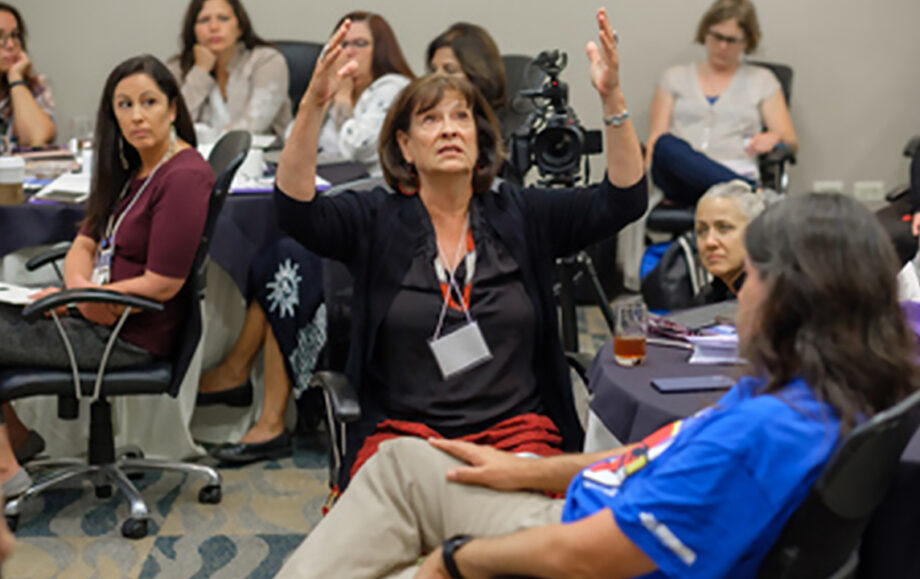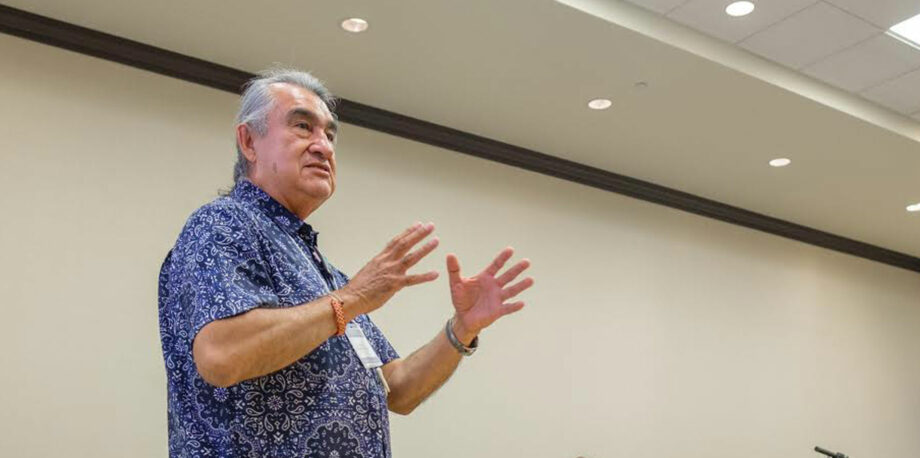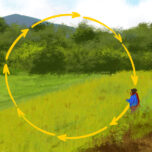September 9, 2020 — Gregory Cajete stands in front of a classroom full of University of New Mexico students enrolled in a graduate seminar on Indigenous nations and sustainable communities. Cajete is teaching these students about having a relationship with, and responsibility for, the environment. This way of knowing is called Native Science, and it is part of a body of evolving Indigenous knowledge based on generations of learning and direct contact with nature.
A Tewa Indian from Santa Clara Pueblo and professor emeritus at the university, Cajete is one of an increasing number of Indigenous educators helping to change how college students learn about the environment and their connection to it. These educators are not trying to turn students away from Western science, but rather teach them to use this body of knowledge, also known as Traditional Ecological Knowledge, in tandem with it.
Cajete says the movement to incorporate Indigenous knowledge into science education and change how students learn about and interact with the environment is growing. Teaching students to care for nature is especially important now, these educators say, because today’s students will be the ones working to address climate change in the future.
A New Era
Cajete helped lay the foundation for this type of learning during his 46 years as an educator. Other scholars are building off the progress and are working to bring Indigenous knowledge into their fields.
Samantha Chisholm Hatfield teaches students at Oregon State University about Traditional Ecological Knowledge by having them go outside and learn about where food comes from. Like many of us, students in her class often get food from a grocery store and don’t think about the process it goes through to get there, she says, so she has them attend a farmer’s market and learn about foods that grow in their area.

Oregon State University research associate Samantha Chisholm Hatfield uses Traditional Ecological Knowledge to teach students about the life cycles of food and water. Photo courtesy of Samantha Chisholm Hatfield
Chisholm Hatfield is an enrolled member of the Confederated Tribes of Siletz Indians, from the Tututni and Chinook Bands, and a research associate for the Oregon Climate Change Research Institute at the university. She says this approach to learning is eye-opening for many students because people have become so divorced from nature. She sees students disconnected from the environment and how the world works and tries to help them reconnect by teaching them to think about the origins of food and water they depend on and the waste they produce. To her, learning Traditional Ecological Knowledge outdoors brings a realness to science that may be hard to find in a lab setting.
She also uses Traditional Ecological Knowledge to teach about conservation and how waste stays in the ecosystem after being thrown away. People often behave as though food, plastic and other materials just disappear after it goes into a bin. With Traditional Ecological Knowledge, there is an awareness that everything is connected – that the material must go somewhere and that it will have some sort of an impact on the environment, whether that be in the air, land or water.
Better Decisions
These educators say it is critical to teach students to connect with nature and equip them with the best information possible because they will be the people dealing with the environmental impacts from choices made generations before them.
“They will make better decisions,” Chisholm Hatfield says.
Another aspect of this knowledge that Western science tends to miss, Chisholm Hatfield says, is the long-term impacts of actions, which has led to problems such as climate change. But such thinking is central to Indigenous knowledge, and Chisholm Hatfield teaches her students this. In Traditional Ecological Knowledge, she says, it’s critical to look at a minimum of three generations’ worth of knowledge before making a decision.
When plastic production boomed in the 1960s and 1970s, Chisholm Hatfield says humans didn’t know the long-term impacts because such compounds didn’t exist a century before. Now microplastics are turning up almost everywhere in the environment — including in drinking water, in food people consume, even in Arctic ice caps and birds’ eggs. If Traditional Ecological Knowledge had been part of the scientific and regulatory process from the beginning, she says, there would have been tough questions asked before such plastics were allowed to be widely produced — including where the plastic would end up and how it would affect air, food and water quality.

Patty Loew talks to a group of Indigenous educators at a workshop last fall focused on incorporating Traditional Ecological Knowledge into their teaching. Photo by Adam Sings in the Timber courtesy of Center for Native American and Indigenous Research
Patty Loew, an enrolled member of the Bad River Band of Lake Superior Chippewa and director of the Center for Native American and Indigenous Research at Northwestern University, says this kind of thinking is needed to address problems like climate change. It is important to teach students to think in this way now, she says, so that when they are making decisions around issues like mining and land management in their future work, they will think about its impact on generations to come.
Cajete agrees, pointing out that this type of education is intended to prevent actions that will do decades of harm to communities. For example, external companies mining uranium in Navajo Nation from the 1940s through 1980s left a legacy of more than 500 abandoned uranium mines, and homes and water sources in Navajo Nation now have elevated radiation levels. Uranium mining has been linked to kidney failure and cancer in Navajo people due to uranium’s chemical and radiological properties. If Traditional Ecological Knowledge had been considered, there may have been better outcomes for people today, advocates say.
Individual Level
Most of the educators teaching Traditional Ecological Knowledge are operating independently of any large, organized movement. Progress is largely happening at the individual level, with no set textbook or framework to work from.
But in fall 2019, about 35 Indigenous educators gathered for a workshop at Northwestern University in Evanston, Illinois, to bring unity to the work they are doing and provide mutual support. They called themselves “decolonizers” and shared stories about what they are doing to incorporate Indigenous knowledge into research and what the future may look like.
During the workshop, these educators discussed how in mainstream higher education institutions the pressure to publish papers and get tenure are barriers to incorporating Indigenous knowledge systems into education and helping communities address challenges like climate change. Many noted that the pressure to get published and bring in funding makes it harder to do research to help tribes.
“We are trying to embed this into the middle of something large,” says Pamala Silas, who coordinated the meeting. Success has varied with these efforts since universities are so different, she added. Some universities are responsive and have more Indigenous faculty than others. Some faculty have been able to build research labs at their university to do this work, while others work on a smaller scale and are housed in Indigenous studies departments.
“When we offer young people coursework and research and an environment that offers these things, they run with it.” – Pamala SilasSilas, an enrolled member of the Menominee tribe of Wisconsin and an associate director for community outreach and engagement in the Center for Native American and Indigenous Research at Northwestern University, says that many students who take courses from Traditional Ecological Knowledge educators resonate with the importance of connecting to the environment.
“When we offer young people coursework and research and an environment that offers these things, they run with it,” she says.
Growing but Small
While this movement is growing, it is still small. Indigenous and Alaska Native educators make up the bulk of those incorporating this knowledge into education, and they made up less than 1% of full-time faculty in degree-granting postsecondary institutions in fall 2018, according to the National Center for Education Statistics.
Most of these educators are in fields such as Indigenous studies and the humanities, Loew says, with a small percentage in science, technology and engineering fields.
She says that while representation is low in academia, Indigenous knowledge is incredibly important in environmental education in particular because Indigenous people live so close to the land. Through experience passed down from generation to generation, they have thousands of years of knowledge related to hunting, gathering and observing changes in the landscape. She says that when people are equipped with such knowledge, it helps them make better decisions about policy and development that affects the environment because they know the environment and connect with it.
Deconstructing Narratives
Even as the approach advances, obstacles remain. One challenge is that students often come to higher education after being taught science through an objective lens disconnected from nature, Chisholm Hatfield says, adding that it’s difficult for educators at the K–12 levels to teach using Traditional Ecological Knowledge because their curriculum is often driven by standardized testing. Many students don’t learn about the importance of relating to and respecting nature until they take a college course with one of these educators.
In Cajete’s experience, students are angry that a nature-centric, long-view approach is not part of their early education. Part of his role as a teacher involves trying to facilitate hope in students that the status quo in environmental education can change.
“Science is a human knowledge system; it can change,” Cajete says. “Education is key. Education is what caused the condition in the first place and education can correct that. …It’s developing very slowly. But it’s developing and moving forward.”
Editor’s note: Natalie Rademacher wrote this story as a participant in the Ensia Mentor Program. The mentor for the project was Kari Lydersen.
Related Posts
Ensia shares solutions-focused stories free of charge through our online magazine and partner media. That means audiences around the world have ready access to stories that can — and do — help them shape a better future. If you value our work, please show your support today.
Yes, I'll support Ensia!



